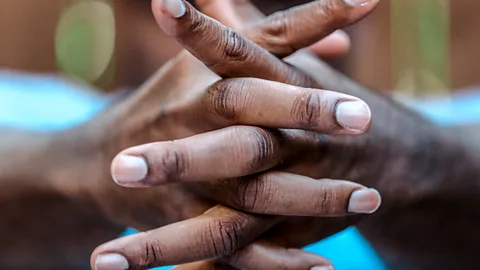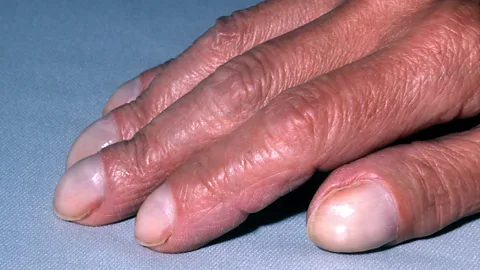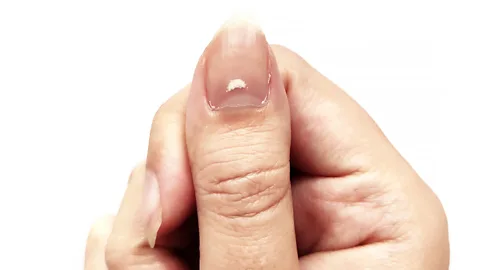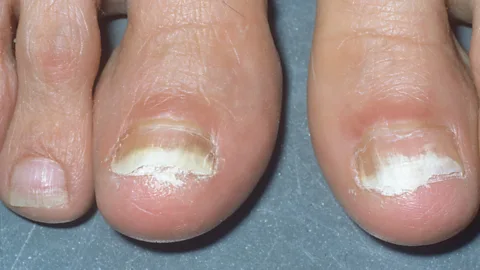What your fingernails can reveal about your health
 Getty Images
Getty ImagesFingernails help protect the underlying skin from injury, and they also come in handy when you want to scratch an itch or peel a satsuma. But what do they reveal about your health?
* All content within this column is provided for general information only, and should not be treated as a substitute for the medical advice of your own doctor or any other health care professional. The BBC is not responsible or liable for any diagnosis made by a user based on the content of this site. The BBC is not liable for the contents of any external internet sites listed, nor does it endorse any commercial product or service mentioned or advised on any of the sites. Always consult your own GP if you're in any way concerned about your health.
There's no shortage of folk wisdom about how to glean the state of your overall health from your nails, such as the pervasive idea that the white flecks that sometimes turn up – known as leukonychia – are a sign of calcium deficiency. But is there any truth to these ideas?
First up some basic anatomy. Nails are an extension of the skin. They are made from keratin, a super tough protein that shields the toes and tops of your fingers from trauma. The half-moon shape seen at the base of the nail is the lunula, which serves as the "growth centre" for the nail, producing the cells that will eventually harden into the nail plate . It sits above the cuticle, a layer of dead cells joining the base of the nailbed to the skin. The cuticle offers extra protection by acting as the nail's security guard, stopping bacteria, fungi and other pathogens in their tracks.
While the eyes might be the windows to the soul, to a doctor the nails can be the windows to your health. Physicians can use them to diagnose all sorts of conditions, from dermatological problems to kidney disease or even autoimmune disorders.
A sign of something serious
"One of the first things I learned in medical school was to look for something called clubbing, where there is this loss of the angle between the nail and the nail bed itself," says Dan Baumgardt, a general practitioner in medicine and lecturer in neuroscience and physiology at the University of Bristol.
With clubbing, the nail beds soften, and the nails almost seem to "float" instead of being firmly attached to the finger. The fingertips also appear large or bulging. "It causes an unusual sort of swollen finger appearance where the finger looks a little bit like a drumstick," says Baumgardt.
Clubbing is a sign of extremely low blood oxygen levels. It is most commonly associated with lung cancer, but it can also indicate an infection of the lining of the heart chambers and heart valves, among other things. Other conditions where it is observed include celiac disease, cirrhosis of the liver and lung infections amongst others.
 Alamy
Alamy"If you do see a patient with clubbing the rule of thumb is to get them an x-ray as an urgency, because it could be an underlying lung cancer that could be explaining it," says Baumgardt. "Having said that even though it's one of the first things that we learned in medical school. I really don't know why, because in all the 14 years I've been a doctor, I've only ever seen it once," he says.
White flecks on the nail – known as leukonychia – are often touted to be a sign of vitamin or mineral deficiencies. However, the evidence to support this is mixed. In one small study of undergraduates, there was no correlation between this symptom and a person's intake of either zinc or calcium. However, in one case report of a patient with Crohn's disease who developed severe leukonychia on his fingernails while deficient in selenium, it disappeared after treatment with this mineral.
In general, leukonychia are more likely to be a result of nail trauma. Stubbing your toe, trapping your fingernail in a door, too many manicures, or dropping a heavy object on your foot may cause such a mark.
Nevertheless, white discolouration on the nail could suggest an underlying health issue. For instance, white marks can be a sign of heavy metal poisoning with lead or arsenic. White discolouration of the nail could be a sign of psoriasis, a chronic skin condition that causes raised, inflamed, scaly patches of skin. If the entire nail turns white, this could suggest a deficiency of protein in the bloodstream, which can indicate kidney disease, liver disease or diabetes.
"If people have low protein levels in their bloodstream it [often] causes the whole nail to go white," says Baumgardt. "We tend to associate that with people who've got liver disease, so things like cirrhosis of the liver, perhaps as a result of alcoholism."
Blue nails, on the other hand, are a sign that the body might be lacking oxygen. It could be a sign of serious heart disease or emphysema and is something you should get checked out by a doctor as soon as possible. This is also the case if you see dark lines underneath the nail, as although this can be caused by trauma, it could also be a sign of subungual melanoma, a rare but serious type of skin cancer.
Bleeding beneath the nail – if it doesn't heal – could also indicate something more serious. "You can get what we call splinter haemorrhages, which look like little red streaks of blood, similar to if you imagine a splinter stuck under your nail," says Baumgardt. "That haemorrhage can sometimes be suggestive of vasculitis, which is an inflammation of the blood vessels. One of the main underlying causes can be an infection of the heart valve, which causes these odd little red swellings," he says.
 Getty Images
Getty ImagesA touch of fungus
Other, more common conditions can also be diagnosed by looking at the nails. When examining a patient, doctors typically look for alterations in colour, thickness and shape.
For example, in a healthy nail the underlying nail bed should be pink except for the white tips. Other colours could indicate an infection of the nail itself, or an underlying health condition.
"If you see either white or yellow discolouration on your toes, especially on your toenails, that is a sign of a fungal infection," says Holly Wilkinson, a lecturer in wound healing at the University of Hull.
Although in many countries, such as the US and the UK, you can buy over-the-counter topical medication for mild fungal nail infections, if you leave it too late then it can become more difficult to treat. (It's important to always consult a doctor if you suspect that you have a nail infection.)
"I think a lot of the time when people have discolouration in the nails they don't realise that it's an infection, so it can get to a point where it becomes quite bad, and then they have to go and see a podiatrist," says Wilkinson.
Fragile nails
Meanwhile the shape of the nail can also reveal underlying problems. Healthy toe and fingernails should be convex, which means they curve slightly outwards. They shouldn't contain any dips or craters. If they do, it may be a sign that you have koilonychia, a condition where the nail curves inwards and looks thin and brittle. In some cases, people with koilonychia have a central depression in their nail deep enough to hold a drop of fluid, hence the condition is often referred to as "spoon nails".
If your any of your nails bear a resemblance to a spoon, this could be a sign of anaemia, when the body doesn't have enough healthy blood cells to carry oxygen to the tissues. Anaemia can be caused by iron deficiency. However, it can also be a sign of coeliac disease, among other conditions.
On the other hand, some changes in the nail can indicate nutritional deficiencies. Some people have horizontal ridges, known as Beau's lines, that run horizontally across their nails. This could indicate a deficiency such as insufficient protein. However, this feature could also be a sign of diabetes and peripheral vascular disease – a disorder involving reduced circulation of blood to certain parts of the body, usually due to the buildup of fat and cholesterol in the arteries – so it is still important to get it checked out.
"Beau's lines can indicate zinc deficiency, while brittle nails are a sign of hypothyroidism or vitamin B7 deficiency," says Mary Pearson, a paediatrician working at the University Hospital of Wales. "In some cases we might be more diligent about looking for these, for example in safeguarding cases where we are concerned about a child's nutrition, or where we suspect chronic disease," she says.
In other cases, nail changes may be caused by lifestyle factors rather than health problems. For example peeling nails, also known as onychoschizia, occurs when thin layers of the nails literally separate from the free nail edge and peel back. "Onychoschizia may be the result of excessive hand washing, nail dryness, and the use of acrylics and other nail polishes," says Joshua Zeichner, professor of dermatology at The Mount Sinai Hospital in New York.
 Getty Images
Getty ImagesYou may wonder what it is about nails that makes them so revealing of a person's underlying health. One of the main reasons is that nails are obviously one of the few parts of the body that you can see from the outside.
"Nails are extensions of the skin, effectively, and your skin can tell you so much about what's going on in your body," says Baumgardt. "Your first impression of a patient often starts from the bedside, so you look them all over and you start off with their nails, you look in their eyes and their mouth. And you start to do an end-of-the-bed assessment, trying to pick out diagnostic pictures from that point early on. So nails are one of the first things we see," he says.
While most of the time changes in the nail are harmless, and are simply down to a nail injury, if you notice that the change in shape, colour, or texture is more permanent, then you should always consult the advice of a doctor.
--
For trusted insights into better health and wellbeing rooted in science, sign up to the Health Fix newsletter, while The Essential List delivers a handpicked selection of features and insights.
